Introduction – The Sumerian Culture of Ancient Mesopotamia
When we talk about the Sumerians, our popular notions mostly pertain to the advanced civilization of Mesopotamia. However, we should also understand that from the historical perspective, it is far more important to talk about the Sumerian culture (which by nature was heterogeneous), as opposed to a singular Sumerian political state.
That is because for the most part of their existence, the Sumerians, as a people, were divided into various city-states and kingdoms mostly within the confines of Sumer – the region of southern Mesopotamia between the Tigris and Euphrates rivers. This area is often described as the core lands of the proverbial Fertile Crescent, leading to the Persian Gulf (present-day southern Iraq).
Once again, historically, the relevance of this ‘meta-region’ relates to it being the focal point of the earliest developments of the Neolithic Revolution, circa 10,000 BC. In essence, Sumer (and Mesopotamia as a whole) is widely considered to have fueled some of the most crucial inventions in human history, ranging from the cursive script, and advanced astronomy to complex mathematics.
Taking such factors into account, let us take a gander at the history and origins of the ancient Sumerians, ranging from their political states, and cultural contributions to utilitarian inventions.
Contents
Sumerians – ‘The Black-Headed People’
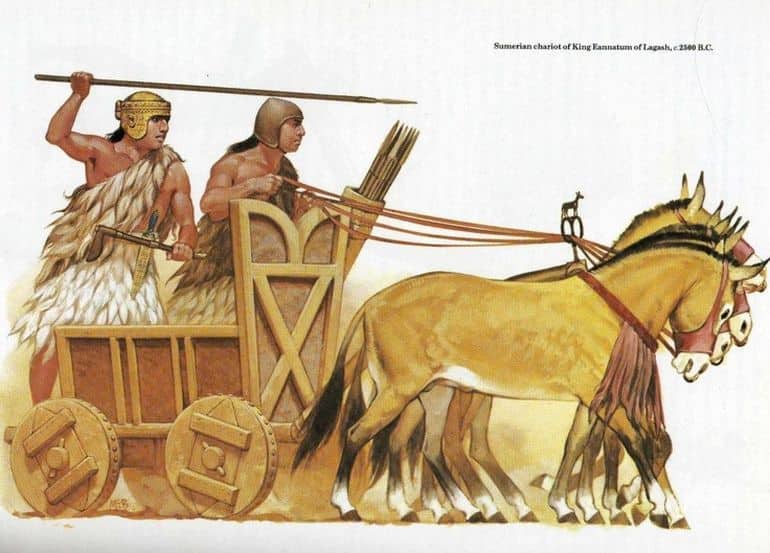
The Sumerians referred to themselves as the ùĝ saĝ gíg ga or ‘black-headed people’, while their land was called the ki-en-gi(-r) – which roughly translates to the ‘place of the noble lords’ or ‘land of the civilized lords’.
Now the Akkadian word Shumer may have represented this term in its own Semitic dialect, although historians are not sure about the phonological development of šumerû or Shumeru (or why such a term was used to designate the southern part of Mesopotamia). In turn, the ancient Hebrew Shinar, Egyptian Sngr, and Hittite Šanhar(a) might be the variants of the Akkadian Šumer – as opposed to what the Sumerians called their native domain.
Historically, it should be noted that the non-Semitic Sumerian as a language almost died out by the 20th century BC, and was only used in a limited official capacity by scholars (much like Latin in our modern times) when the Epic of Gilgamesh, as we know today, was compiled (circa 18th century BC).
However, at the same time, it heavily influenced the Semitic Akkadian (of which Babylonian was a variant), the lingua franca of much of the Ancient Near East. This scope of common influence and lexical borrowings were so heavily pronounced that many scholars consider both languages to have linguistically converged, known as sprachbund or “federation of languages”.
Chronological History of Sumerians –
Origins of Sumerians (circa 6500 – 4100 BC)
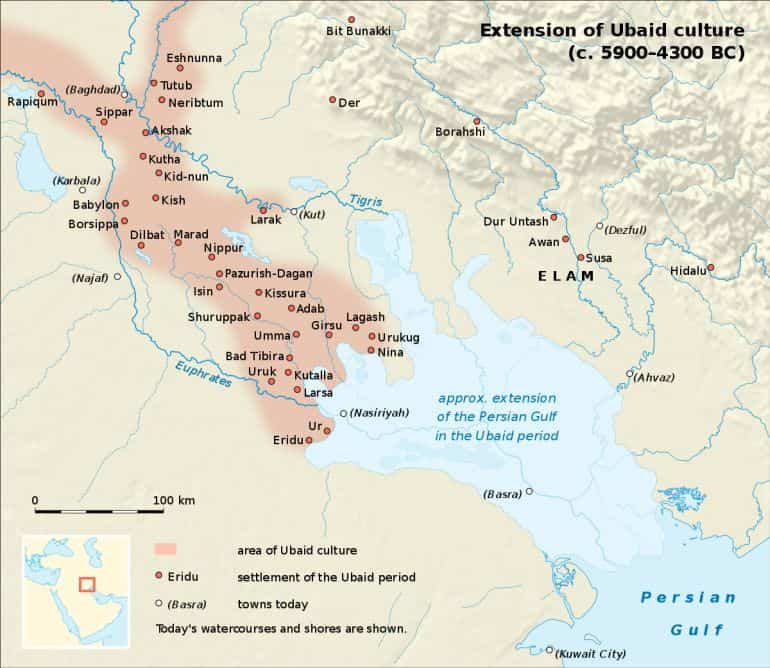
This brings us to the question – how was the Sumerian civilization kick-started? Well, 19th-century historians had hypothesized that Sumer was inhabited since 4500 BC. However, modern scholars have found evidence of how the area was settled for a longer period of time, possibly since 6500 BC. The first known people who settled in this region are termed the Ubaids (derived from Tell al-‘Ubaid, one of the earliest known excavation sites in the area).
They made the momentous transition from hunter-gatherer groups to what we can call the nascent stages of civilization. Pertaining to the latter, the prehistoric Ubaid Period and culture (that also spread to Bahrain and Oman) had its fair share of unwalled village settlements, the tiered hierarchy of buildings, and the architectural compositions of elementary temple buildings – all of which were developed further by the later Sumerian people.
By 4500 BC, the organized spatial scopes and noticeable levels of ‘urbanization’, mirrored by Eridu – the first known major city in Mesopotamia, were complemented by widespread irrigation-based agriculture and storage advancements, with discovered tools and objects like painted pottery, sickles, hoes, and bricks.
On the social level, stratification became more ingrained, thus giving rise to a hierarchical structure dominated by an elite class (composed of hereditary chieftains). This, in turn, led to a greater focus on bigger buildings, larger shrines, and richer graves, along with rudimentary defense measures.
The Uruk Ascendancy (circa 4100 – 2900 BC)
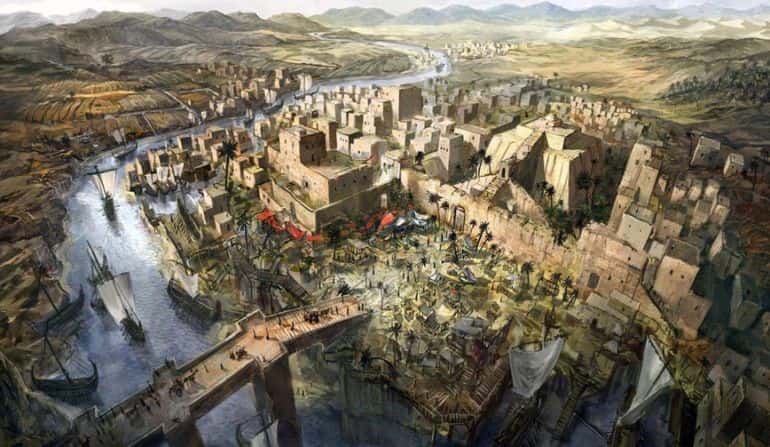
Unfortunately, from the historical perspective, scholars are not sure of the origins of the Ubaids, although there are hypotheses regarding how they were an offshoot of the Samarra Culture from northern Mesopotamia.
More importantly, researchers are still uncertain about the origins of the ‘proper’ Sumerians and how they inherited the semi-urbanized scope of the Ubaid Period. In terms of physical evidence, archaeologists have observed the gradual shift from localized pottery-making to mass-scale pottery production on presumably fast-spinning wheels.
Interestingly enough, from the mythological side of affairs, the ascendancy of whom we know as Sumerians in the place of Ubaids can be discerned from the touted importance of Uruk as the main city under its patron goddess Inanna. In the mythical narrative, the later-mentioned deity took away the gifts of me (civilization) from Enki, the patron god of Eridu – the major city of the previous Ubaid Culture.
However, whether these Sumerian people arrived through migrations or were already an existing ethnic group in the region (a conjecture preferred by a majority of the researchers) is still debated in academic circles.
Thus the era is called the Uruk Period (circa 4100 – 2900 BC), and it saw the rise of city-states and greater urbanization bolstered by higher agricultural productivity, canal-based transportation, flourishing trade routes via rivers, and centralized administrations. Suffice it to say, the social hierarchy became even more deep-rooted – mirrored by temple precincts and palaces taking up the center of gradually growing towns and cities.
For example, the city of Uruk itself probably boasted a population of around 40,000 people enclosed in a substantial area of over 300 hectares. Other towns in southern Mesopotamia continued to expand into urbanized Sumerian cities, with examples like Kish, Ur, Nippur, Umma, Nina, and Girsu.
The Kings of the Sumerians (circa 2900 – 2334 BC)
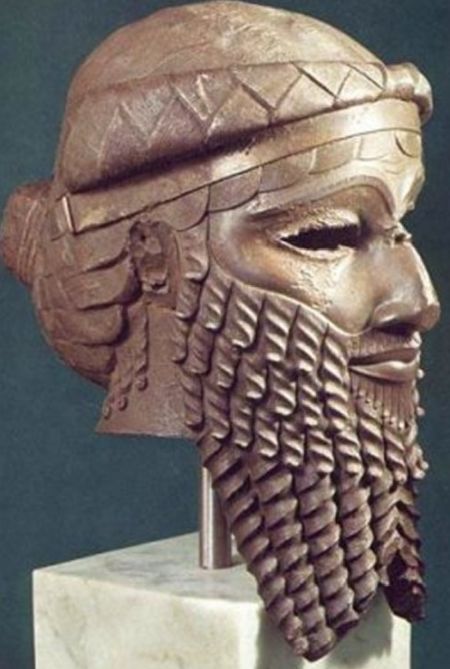
From chieftains and the council of elders, there was a societal progression to kings and overlords of entire city-states, with the early dynastic period of the Sumerians starting from circa 2900 BC. These monarchs, known as lugal (‘big man’ or ‘great man’), were perceived as the figurative heads and representatives of the main temple precincts within the cities, albeit with a more secular and regal appeal (as opposed to just religious priest-kings or ensi).
Once again, on the mythical narrative side of affairs, many of such lugal mentioned in the Sumerian King List achieved supernatural feats. For example, Etana, the earliest known king whose accomplishments are recorded, was able to produce an heir after finding the plant of birth in the sky by riding an eagle.
Beyond legends, there are scant archaeological pieces of evidence to suggest the existence of real figures, like Enmebaragesi of Kish, who reigned during circa 26th century BC and is incredibly also mentioned in the Sumerian version of the Epic of Gilgamesh. Moreover, delving deeper into etymology, the very name Enmebaragesi is probably not Sumerian but rather Semitic (Eastern Akkadian) in origin.
This further alludes to how the expanding Sumerian realms in southern Mesopotamia were not only beginning to incorporate neighboring lands but also proximate cultures. As for the growing urban scope of the settlements, cities were now starting to be walled and fortified, thus suggesting the occurrence of power struggles and conflicts in the region.
On the political side of affairs, Sumer was not known to be unified during this era. Instead, much like the ancient Greeks and their realms, the region of southern Mesopotamia was divided into city-states, each with its own king, expansive capital with city walls, and patron deity.
However, in circa 2450 BC, the city-state of Lagash and its king Eannatum may have created the world’s first known empire (even though for a very brief period) by annexing other important Sumerian city-states like Kish, Uruk, and Larsa, along with parts of neighboring Elam (in Iran).
He went on to finally defeat the rival city-state of Umma in the first known recorded battle (as mentioned in the Stele of the Vultures) that used a phalanx formation. But soon after his death, the Umma exacted their revenge by capturing Lagash. They possibly also established a briefly unified Sumerian Kingdom with Uruk as its capital. Their king Lugal-Zage-Si was recorded as the last Sumerian ruler before the rise of Sargon of Akkad.
Interlude – The Akkadian Empire (circa 2270 – 2083 BC)
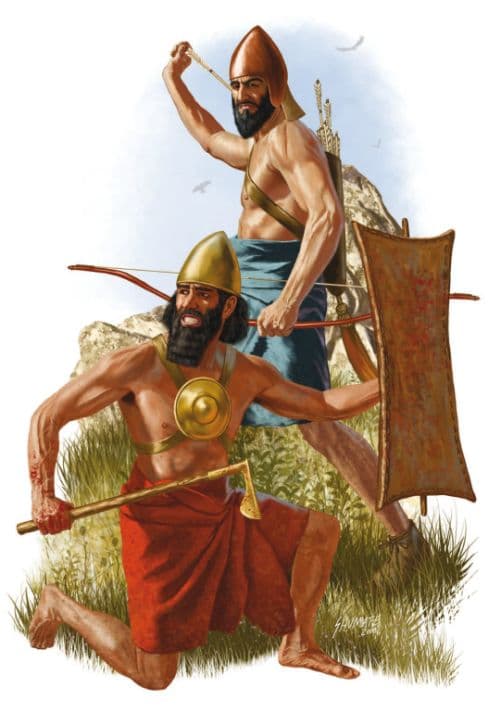
We have already fleetingly mentioned the influence of both the Old Akkadian language and culture on the Sumerians. However, in circa 23rd century BC (or possibly 24th century BC), Sargon of Akkad, who is mentioned as the son of the gardener of a previous Sumerian king (in the King’s List), usurped the throne and defeated Lugal-Zage-Si by successfully capturing his capital Uruk
This incredible feat established the Akkadian Empire encompassing most of Sumer. He hailed from Akkad, the Mesopotamian city whose archaeological evidence has eluded modern-day scholars.
Consequently, by carving up one of the first known all-Mesopotamian empires that existed for around 180 years, Sargon momentously ‘united’ the speakers of both non-Semitic Sumerian and Semitic Akkadian. In fact, by the middle of the 3rd millennium BC, the Akkadians managed to create a culturally syncretic scope (that encompassed a melting pot of different ethnicity and city-states).
This ultimately paved the way for the emergence of Akkadian as the lingua franca of Mesopotamia and even neighboring Elam for centuries to come. Even in the religious scheme of things, Sargon established his foothold by making his very own daughter the priestess of Nanna – the patron Moon God of Ur (known as Sin in Akkadian).
And, beyond just cultural affiliations with the advanced Sumerians, the Akkadians also adopted (and loaned) many of the military systems and doctrines of their Mesopotamian brethren.
But the practical superiority of the Akkadian (and Sumerian) warrior culture must have been related to the use of wheels – an invention that not only allowed for more complex logistical support but also heralded the development of chariots, the ponderous heavy shock wheeled vehicles of the Bronze Age.
Unfortunately, the Akkadian Empire, which was increasingly fractured by the latter half of the 22nd century, finally crumbled in the face of a Gutian onslaught, which possibly came from the vicinity of the Zagros Mountains in Iran. The resultant era (circa 2050 BC), dominated by the Gutian dynasty and a second dynasty from Lagash, was often called the proverbial ‘Dark Age’ of Mesopotamia by ancient sources.
The Sumerian Revival (circa 2047 – 1750 BC)
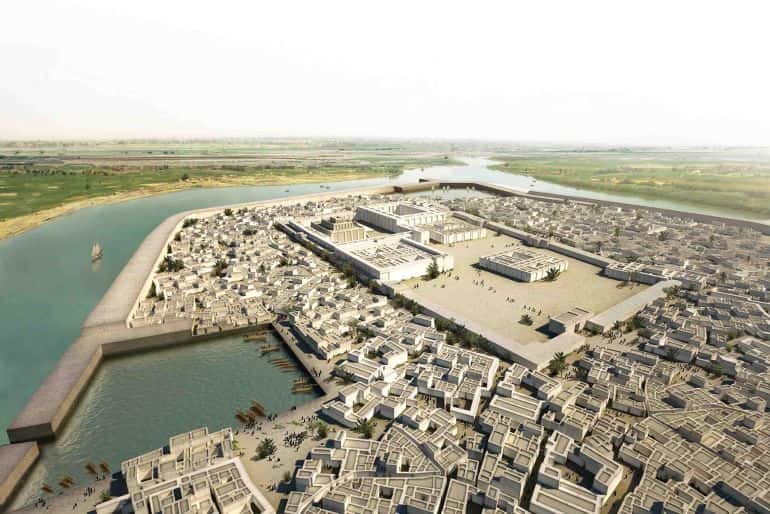
The last hurrah for the Sumerians, at least from the perspective of rulership, was brought forth by the Third Dynasty of Ur (circa 2047-1750 BC) – which was once again successful in unifying parts of southern Mesopotamia under Sumerian control (a period known as the Sumerian Renaissance).
The aforementioned two-way influence surely rubbed on the dynamic dynasty, whose Neo-Sumerian kings openly emulated the heroic feats of renowned Akkadian rulers like Sargon the Great and Naram-Sin.
And while many of these endeavors were clearly propagandist in nature, some did culminate in magnificent projects, like the famed Ziggurat of Ur. Possibly constructed under the orders of the first king Ur-Nammu, the step-pyramidal structure is estimated to have encompassed an area of 64 m (210 ft) in length x 45 m (148 ft) in width while rising to a height of around 100 ft. The building was completed during the reign of Ur-Nammu’s son Shulgi, who promptly proclaimed himself as the divine ruler of the proximate lands.
Beyond just monumental structures, the Third Dynasty of Ur in many ways epitomized the apical stage of the Bronze Age realm of Ur. For example, as opposed to our popular notions denoting the Code of Hammurabi as the oldest set of codified laws, the actual honor possibly belongs to the Code of Ur-Nammu, which was inscribed circa 2100 – 2050 BC.
His son Shulgi took a step further by reforming the emergent kingdom into a highly centralized bureaucratic state. His amendments were complemented by personal resolve, so much so that a particular incident alludes to how the king covered (or ran) 100 miles (160.9 km) between Nippur and Ur and back again, in one day, in order to attend religious festivals in both cities.
During all of these far-flung administrative changes, the Sumerian capital city of Ur itself became the bastion of culture and learning in southern Mesopotamia. The age coincided with the rise of trade and efficient urban management, along with the encouragement of artistic and scientific pursuits.
In that regard, it can be surmised from archaeological pieces of evidence that the residents of Ur possibly enjoyed better standards of living than many of the urban dwellers of contemporary Mesopotamian cities.
The Fall of Ur and the Sumerians (circa 18th century BC)
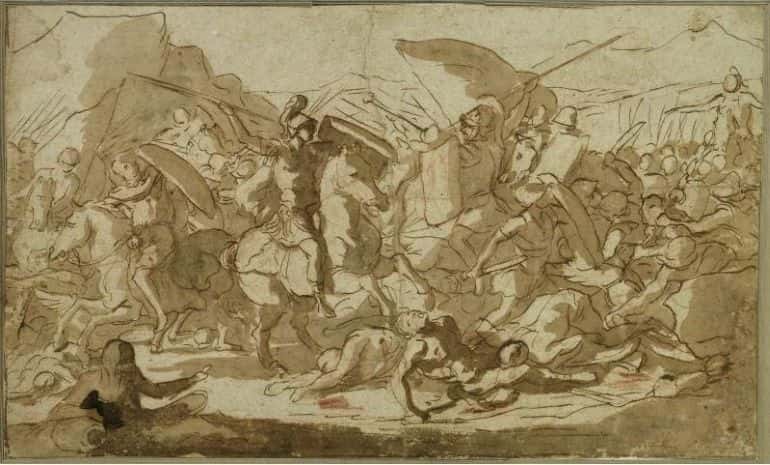
It was during Shulgi’s rule that an extensive wall was constructed between the rivers Tigris and Euphrates (possibly 155 miles long) to keep out the ‘barbarian’ Semitic-speaking, semi-nomadic Martu (better known as Amorites, the tribe of Hammurabi).
And while the massive wall flaunted its architectural prowess, the Sumerian defense, dilapidated over time, was breached by the neighboring Elamites, who went on to sack Ur and capture the last Neo-Sumerian king Ibbi Sin, in circa 2004 BC.
The resulting chaos saw the brief ascendancy of the Assyrians in the Middle East until they were eclipsed by the Amorites with their base of power centered around the mighty city of Babylon (circa 18th century BC).
Consequently, over the period of these two centuries, the Sumerians diminished and finally ceased to exist as a definitive kingdom or city-state, while their spoken language was already replaced by the Semitic Akkadian and Babylonian (although it was still used in an official capacity as a literary language, like modern-day Latin).
Now beyond military struggles, some historians have pointed out how the Sumerians were already hamstrung by a shift in population from southern to northern parts of Mesopotamia. The reasons could have been related to famines and agricultural decline set in part due to climate change and (possibly) the high salinity of the soil resulting from improper irrigation agriculture.
As a result, the dwindling Sumerians were eventually absorbed into the prevalent Akkadian/Babylonian population. However, the indubitable yet oft-ignored legacy of the Sumerians can still be felt in the present era, with examples like the time-based division of a day into 24 hours.
Cultural History of Sumerians –
Cursive Writing and Copper Fabrication
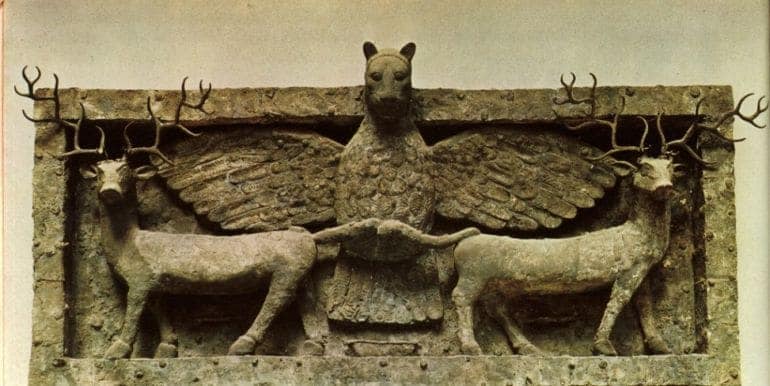
We have already talked about the importance of spinning wheels for pottery making. But the other great invention of the Sumerians arguably relates to writing and how it represents the physical manifestation of our power of speech.
But while the spoken language was probably in use by 35,000 BC, its fully developed written form (as opposed to proto-writing) only made its ‘debut’ during the latter part of the 4th millennium BC (circa 3500-3100 BC) in Sumer, southern Mesopotamia.
This form of early cursive writing system is known as the cuneiform – and it is widely viewed as the most significant contribution by the city of Uruk. Interestingly enough, ancient Egyptians also formulated their native writing system by 3100 BC; and one hypothesis, although hotly debated, suggests that their system (corresponding to First Dynasty) was partly influenced by the Mesopotamian cuneiform writing.
As for the history of metals, copper became the first metal to be smelted from its ore (circa 5000 BC), the first metal that was cast in a mold (circa 4000 BC), and the first metal that was alloyed with yet another metal (tin) to create bronze (circa 3500 BC).
Interestingly, copper counts among the few metals that can be used (to some degree) in its natural form, as opposed to extraction from ore. However, its full-scale usage in a fabricated form was probably kickstarted by the Sumerians, around 5,000 years ago.
In fact, the fabrication of copper as a major Sumerian invention rather coincides with the growth of organized urban spaces into veritable cities like Uruk, Ur, and al’Ubaid. In terms of ‘products’, the Sumerians invented and devised copper arrowheads, harpoons, razors, and other smaller objects.
Over the next centuries, they made their transition to more complex geometric forms, like chisels, elaborate jugs, and drinking vessels. Suffice it to say, there are some exquisite copper objects, like the Imdugud relief (pictured above) dated from circa 3100 BC, that provide a fitting testament to the incredible craftsmanship of the Sumerian artisans.
World’s Oldest Known Literature
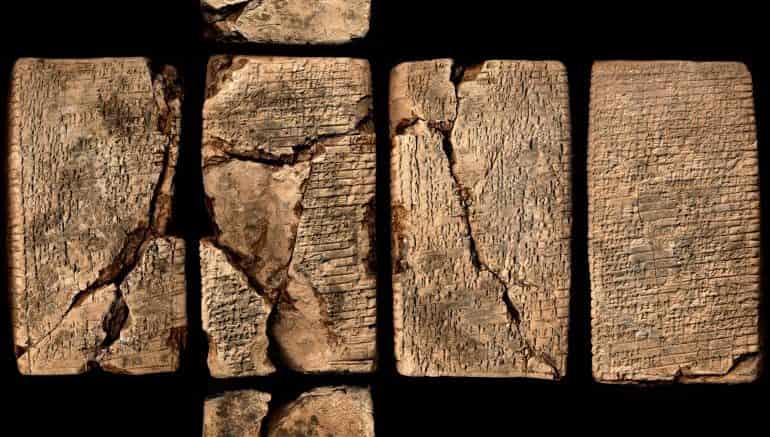
Quite unsurprisingly, like many man-made achievements (including wheels and law codes), literature had its origins in ancient Sumer, the cradle of civilization. In fact, the development of literature was a direct effect of the invention of written language, an achievement, as we discussed earlier, is generally attributed to the Sumerians, circa 3400 BC.
And while in Sumerian written history, these cuneiform texts, inscribed on clay tablets and reliefs, started out as recording devices for administrative purposes, over time Sumerian scribes also copied literature pieces that presented tales, myths, and essays. In that regard, the world’s oldest known literature pieces pertain to two such surviving specimens – the Kesh Temple Hymn and the Instructions of Shuruppak.
The Kesh Temple Hymn (also known as the Liturgy to Nintud) is basically related to a series of Sumerian clay tablets that were inscribed circa 2600 BC. As for the core content of this ancient literature piece, the narrative (comprising the hymn) mainly revolves around how Enlil, the Sumerian god of breath and wind, heaps his praise upon the city of Kesh since the settlement’s temple is chosen for the assembly of the gods known as Ekur.
Interestingly enough, the hymn itself is attributed to yet another divine being – Nisaba, the goddess of vegetation, writing, and literature. In essence, the Kesh Temple Hymn was presented as the work of gods, possibly to endow it with an air of legitimacy (and sanctity) during ancient times.
The other literary work that is generally considered among the oldest in the world (and possibly the world’s oldest surviving written text) pertains to the Instructions of Shuruppak. Touted as one of the better examples of Sumerian wisdom literature, the ‘piece’ comprises a group of clay tablets in a cuneiform script – dating from around 2600-2500 BC, originally discovered at Abu Salabikh (around 12 miles from ancient Nippur).
In accordance with Sumerian traditions and annals of kings, Shuruppak was the son of Ubara-Tutu, the last king of Sumer before the Deluge – the great flood myth that has its parallel in many ancient tales ranging from Gilgamesh (Babylonian), Manu (Indian) to Noah (Biblical).
Thus, the range of wisdom offered by the father to his son (and eventual hero) oscillates between simple practicality to upholding morality. For example, some of the practical instructions say –
You should not locate a field on a road.
You should not make a well in your field: people will cause damage on it for you.
Other philosophical and morality-based counsels talk about –
A loving heart maintains a family; a hateful heart destroys a family.
You should not play around with a married young woman: the slander could be serious.
Do not pass judgment when you drink beer.
The Mythology of the Sumerians
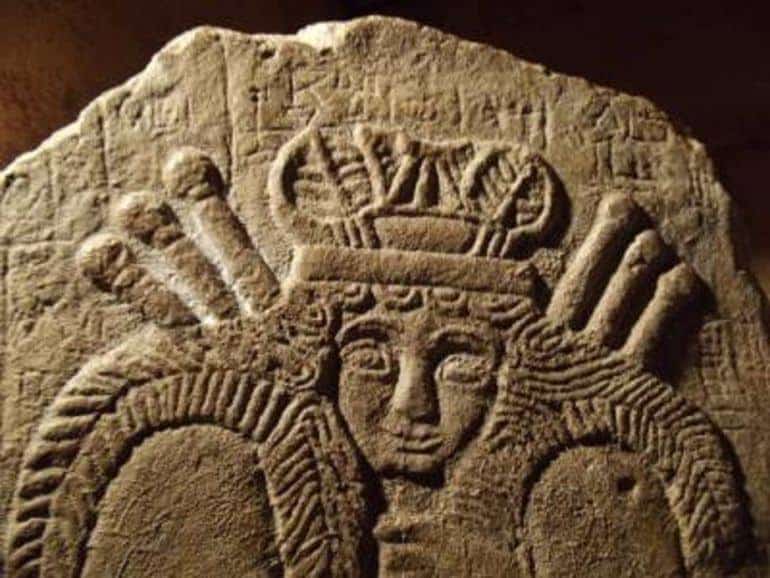
In the introduction, we talked about how in the early historical scope of Mesopotamia, there were no singular factions or political entities that ruled the extensive lands between and around the rivers of Tigris and Euphrates (at least until the brief Akkadian interlude and the later ascension of the Neo-Sumerians, Babylonians and Neo-Assyrians).
However, the Mesopotamian city-states from after the 3rd millennium BC did share their cultural traits and even languages. The latter example pertains to how ancient Sumerians heavily influenced Akkadian (of which Babylonian was a variant), the lingua franca of much of the Ancient Near East.
The pantheon of the region was a religious extension of this ancient cultural overlap, and as such many of the Mesopotamian gods were commonly worshiped by Sumerians, Babylonians, and even Assyrians alike. In essence, the Sumerians believed in an anthropomorphic polytheism, a system basically comprised of many gods (or divine entities) who were unique to each city-state and were worshiped in their human form.
But as most of us aficionados would know, the progression of history is not linear, and as such many of the Mesopotamian mythological characters evolved (and devolved) into variant entities (based on the faction’s preference – like Sumerian sun god Utu ‘morphed’ into Akkadian Shamash).
Furthermore, since some of these Sumerian (and Mesopotamian) gods were honored more as patron deities of individual cities, their lasting religious influence in other areas is more debatable. And lastly, as for one of the first known supreme triads in a pantheon, Sumerians probably venerated Enlil (the god of air), Anu (the god of heavens), and Enki (the god of earth).
Bilgames – The Sumerian Precursor to Gilgamesh
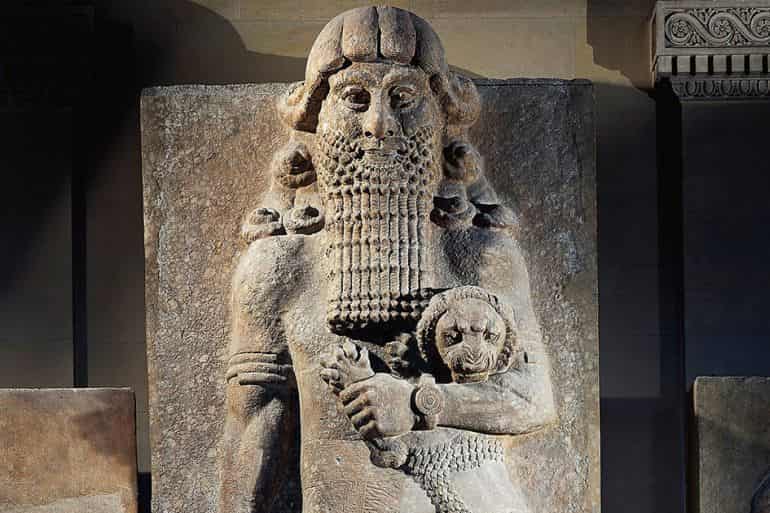
Befitting the literary value of the Epic of Gilgamesh, the multilayered history of the character of Gilgamesh himself is fascinatingly derived from five Sumerian poems (dating from circa 3rd millennium BC) that portray a King of Uruk named ‘Bilgames‘.
To that end, historians are aware of the existence of a few such independent stories of Gilgamesh (or his Sumerian counterpart) that were composed before the epic poem itself. Some of these pieces of ‘pre-epic’ evidence are also derived from 3rd millennium BC inscriptions that credit Gilgamesh with the building of the great walls of Uruk, corresponding to present-day Warka in Iraq.
As for the first iterations of the epic itself, they were possibly compiled in ‘Old Babylonian’ versions (circa 18th century BC). Simply put, while the provenance of these literary works is based on Sumerian language and literature, the end product/s (as available to common people) of the epic were possibly composed in Babylonian and related Akkadian – languages that were different from Sumerian, based on their Semitic origins.
The First Known Law Codes of Humanity
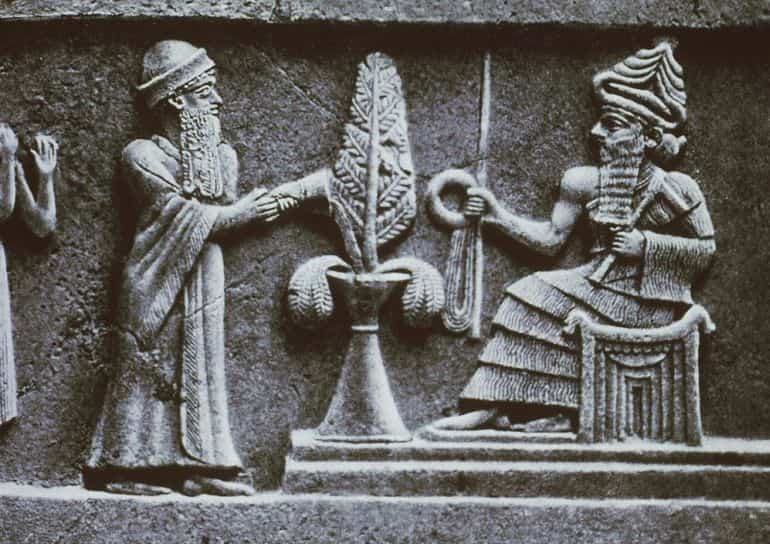
A common misconception relating to the Code of Hammurabi is its presumed nature of being the oldest set of codified laws in human history. That is however not true from the historical perspective, with the honor (of the oldest surviving law code) probably belonging to the Sumerian Code of Ur-Nammu, which was inscribed circa 2100 – 2050 BC.
Moreover, many scholars have also put forth their views regarding an even older law code encompassing the legal reforms of Urukagina, the Sumerian king of the city-state Lagash in southern Mesopotamia (Sumer), from circa 24th century BC. Unfortunately, no extant text has survived from this legal code, and so much of its content has been surmised from other ancient references.
From the literary perspective, the Code of Ur-Nammu was composed in Sumerian, and as such 30 of its 57 prescribed laws have been reconstructed by historians. Some fascinating (and often bizarre) examples are presented as follows –
If a man violates the right of another and deflowers the virgin wife of a young man, they shall kill that male.
If a man is accused of sorcery he must undergo ordeal by water; if he is proven innocent, his accuser must pay 3 shekels.
If a man knocks out a tooth of another man, he shall pay two shekels of silver.
If a man appeared as a witness, and was shown to be a perjurer, he must pay fifteen shekels of silver.
If a man stealthily cultivates the field of another man and he raises a complaint, this is however to be rejected, and this man will lose his expenses.
Honorable Mention – Penchant for Beer
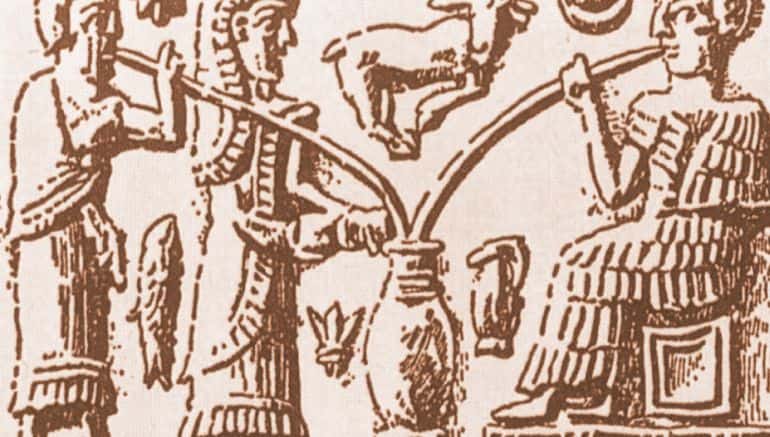
The oldest known standard recipe for brewing beer comes from ancient Sumer. Simply put, the first deliberate production of beer (or ale) in history can be attributed as one of the achievements of Sumerians, with the evidence of the oldest known surviving beer recipe contained within a 3900-year-old poem – Hymn to Ninkasi.
Now in terms of Mesopotamian mythology, Ninkasi was the ancient Sumerian tutelary goddess of beer (and alcohol). Symbolizing the socially important role of women in brewing and preparation of beverages in ancient Mesopotamia, the entity (whose actual depictions have not survived the rigors of time) historically also alluded to how beer consumption in itself was an important marker for societal and civilized virtues.
Some of the excerpts from this 3900-year-old Sumerian poem honoring Ninkasi (the Hymn to Ninkasi), translated by Miguel Civil, read like this –
You are the one who soaks the malt in a jar,
The waves rise, the waves fall.
Ninkasi, you are the one who soaks the malt in a jar,
The waves rise, the waves fall.
.
.
.
When you pour out the filtered beer of the collector vat,
It is [like] the onrush of Tigris and Euphrates. Ninkasi, you are the one who pours out the filtered beer of the collector vat,
It is [like] the onrush of Tigris and Euphrates.
Coming to the historical scope of beer consumption, while the first known literary evidence, in the form of the Hymn to Ninkasi, dates from circa 1800 BC, the ‘brewing song’ in itself is undoubtedly older. In other words, beer was made and consumed in Sumer long before the onset of the 19th century BC.
In fact, archaeological evidence for brewing beer in the southern Mesopotamian region dates back to circa 3500 BC (or possibly even before). Researchers were able to identify chemical traces of beer in a fragmented jar at the ancient Sumerian trading settlement of Godin Tepe, in modern-day Iran. As for their consumption method, given the thick consistency of the beer, drinking straws were used to circumvent the bitter solids left over from the fermentation process.
Online References: Ancient Encyclopedia / Penfield.edu / Lumen Learning / University of Chicago
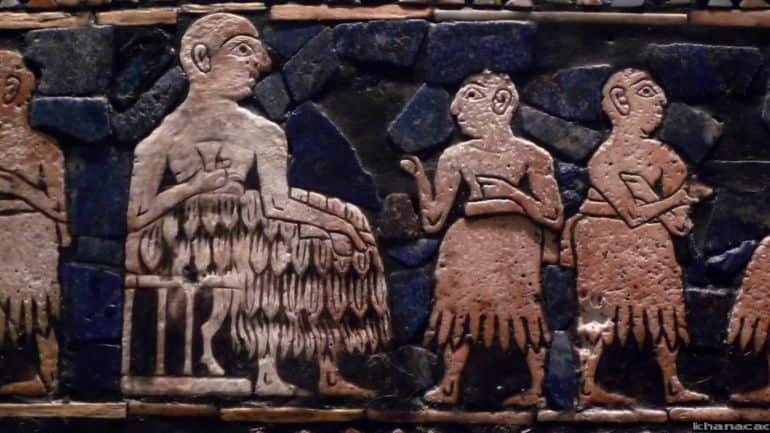
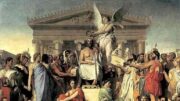
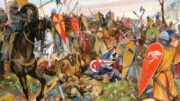
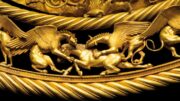

Be the first to comment on "Who Were The Ancient Sumerians? History of the ‘First’ Mesopotamians"